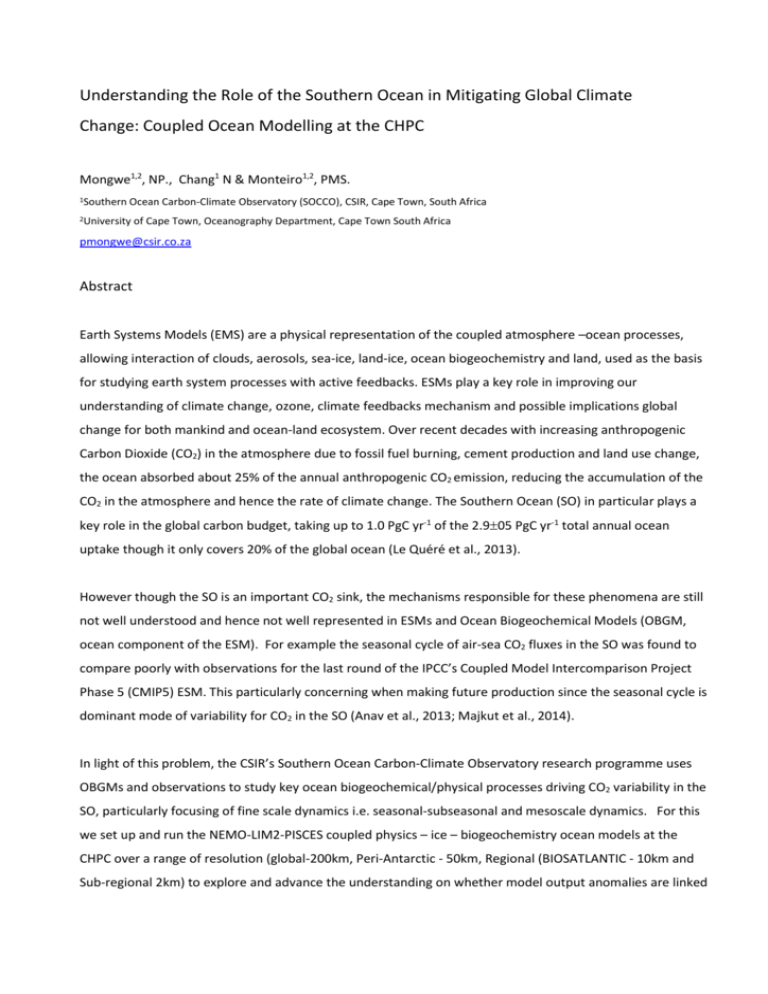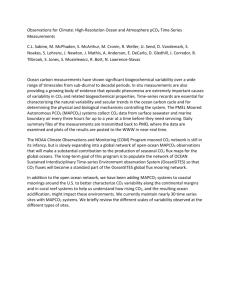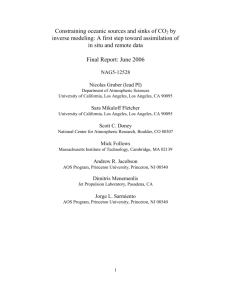Precious Mongwe, CSIR
advertisement

Understanding the Role of the Southern Ocean in Mitigating Global Climate Change: Coupled Ocean Modelling at the CHPC Mongwe1,2, NP., Chang1 N & Monteiro1,2, PMS. 1Southern Ocean Carbon-Climate Observatory (SOCCO), CSIR, Cape Town, South Africa 2University of Cape Town, Oceanography Department, Cape Town South Africa pmongwe@csir.co.za Abstract Earth Systems Models (EMS) are a physical representation of the coupled atmosphere –ocean processes, allowing interaction of clouds, aerosols, sea-ice, land-ice, ocean biogeochemistry and land, used as the basis for studying earth system processes with active feedbacks. ESMs play a key role in improving our understanding of climate change, ozone, climate feedbacks mechanism and possible implications global change for both mankind and ocean-land ecosystem. Over recent decades with increasing anthropogenic Carbon Dioxide (CO2) in the atmosphere due to fossil fuel burning, cement production and land use change, the ocean absorbed about 25% of the annual anthropogenic CO2 emission, reducing the accumulation of the CO2 in the atmosphere and hence the rate of climate change. The Southern Ocean (SO) in particular plays a key role in the global carbon budget, taking up to 1.0 PgC yr-1 of the 2.905 PgC yr-1 total annual ocean uptake though it only covers 20% of the global ocean (Le Quéré et al., 2013). However though the SO is an important CO2 sink, the mechanisms responsible for these phenomena are still not well understood and hence not well represented in ESMs and Ocean Biogeochemical Models (OBGM, ocean component of the ESM). For example the seasonal cycle of air-sea CO2 fluxes in the SO was found to compare poorly with observations for the last round of the IPCC’s Coupled Model Intercomparison Project Phase 5 (CMIP5) ESM. This particularly concerning when making future production since the seasonal cycle is dominant mode of variability for CO2 in the SO (Anav et al., 2013; Majkut et al., 2014). In light of this problem, the CSIR’s Southern Ocean Carbon-Climate Observatory research programme uses OBGMs and observations to study key ocean biogeochemical/physical processes driving CO2 variability in the SO, particularly focusing of fine scale dynamics i.e. seasonal-subseasonal and mesoscale dynamics. For this we set up and run the NEMO-LIM2-PISCES coupled physics – ice – biogeochemistry ocean models at the CHPC over a range of resolution (global-200km, Peri-Antarctic - 50km, Regional (BIOSATLANTIC - 10km and Sub-regional 2km) to explore and advance the understanding on whether model output anomalies are linked to model resolution’s impact on the physics or on the parameterization of the biogeochemistry. The NEMOPISCES models scale well on the Dell Cluster of the CHPC and most of these runs are undertaken on the allocation of 1000 cpus. This work contributes towards the recent endeavor to building South Africa’s first ESM. Here we present one of recently submitted work on modelled CO2 in the SO (Mongwe et a., submitted) . In this study we present a methodological framework to diagnose the process dynamics of CO2, which might help explain anomalies in the seasonal cycle of air-sea CO2 fluxes in model outputs with relative to observations. We test this framework by contrasting the NEMO-PISCES ocean model ORCA2-LIM2-PISCES relative to the Takahashi 2009 (T09) CO2 dataset. We demonstrate that the seasonal cycle anomaly for CO2 fluxes in ORCA2LP is linked to an underestimation of winter convective CO2 entrainment as well as the impact of biological CO2 uptake during the spring-summer season relative to T09 observations. And as a consequence this resulted in Sea Surface Temperature (SST) becoming the dominant driver of seasonal scale pCO2 variability and hence CO2 air-sea fluxes in the model.









